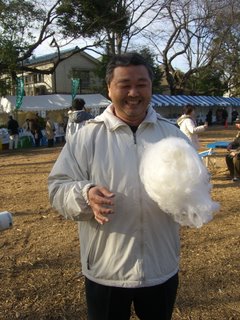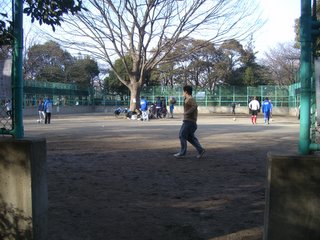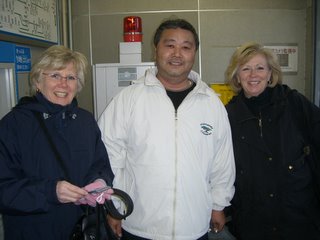A Subway Is More Than A Sandwich!!
There are so many places to see in and about Tokyo, and so little time! The days are now getting longer, and we have stretches of warmer weather, even if the #@!$*&ing plum blossoms are still nowhere to be seen! The deal is, if you are going to get around town, you have to be able to handle the subway system; like it or not. Distances are simply too great for bikes, taxis are too expensive, and cars are not an option due to the congestion and the money involved. So, gird your loins, (always a good move when the crush from the door opening implodes a pack of commuters into the car), and be prepared to do whatever it takes to master this most daunting of personal challenges.
The subway system here is truly awesome, bu t only once the traveller can decipher some of the deeper mysteries and concealed beauty of its internal workings. Like, the basic train-routes, for one thing. The attached photo gives you just a hint of the formidible complexity that lies waiting within the bowels of this sprawling transportation system. The Greater Tokyo Subway System is an intricate blend of both private and public rail companies, each with different rolling stock, signage, fare rates, passes, schedules, and even station layouts. The language barrier you face, (typically you can't even read the signs), only deepens the challenge. At first it is all just a confusing jumble of seemingly choatic and randomly selected physical and mental tests of your will and endurance. But, if you can percievere, the subway system slowly begins to reveal the true beauty of its inner workings to the prevlidged cognesenti.
t only once the traveller can decipher some of the deeper mysteries and concealed beauty of its internal workings. Like, the basic train-routes, for one thing. The attached photo gives you just a hint of the formidible complexity that lies waiting within the bowels of this sprawling transportation system. The Greater Tokyo Subway System is an intricate blend of both private and public rail companies, each with different rolling stock, signage, fare rates, passes, schedules, and even station layouts. The language barrier you face, (typically you can't even read the signs), only deepens the challenge. At first it is all just a confusing jumble of seemingly choatic and randomly selected physical and mental tests of your will and endurance. But, if you can percievere, the subway system slowly begins to reveal the true beauty of its inner workings to the prevlidged cognesenti.
From time to time, the niave Gaijin trying out the subway system for the first few weeks will get hints of the hidden order of the universe as sort of a 'freebe' gift from the Gods of Displacement. Unfortunately, we miserable neophytes are usually too ignorant to even see, let alone understand, this enlightening act of unsolicited benevelance. This 'gift of insight' usually appears in such magical forms as: you are the only person lined up for the train on the LEFT side of the platform, while everyone else is standing on the RIGHT side. Or, your train rolls into the station and EVERYONE ELSE gets off, leaving you sitting in an empty car and wondering where they are all going. (If you are lucky, the conductor will take pity on you, enter the car, and explain as best he can that this is END OF THE LINE.) Or, (one of my personal favourites), you notice that the station-name symbols on the EXIT sign at the station are EXACTLY THE SAME as the ones that were above the ENTRANCE sign of the station from which you departed three transfers and 90 minutes ago!
No, we miserable and much-pitied Gaijin usually ignore these acts of gratitutious mercy; we prefer to learn most things the hard way. Like, when the train says it will be here at 10:36 it will! Not at 10:35, or even 10:39. So don't count on it being there if you are even ONE MINUTE late! Also, if you think you got a deal because the ticket taking machine at the exit wasn't working when you left, the next time you enter the system it will think that you have been wandering aimlessly throughout its innards for the past three days and will try to charge you accordingly! (This resulted in me smiling at a stoic Transit Official in the little booth and mumbling over and over the word Akaharara! - the only word from my extensive vocabulary of Japanese For Dummies that he seemed willing to admit might even possibly be in his native tongue. ) [Akahabara is a major station on the line, where the maintenance work on its ticket machines is obviously suspect.] Sh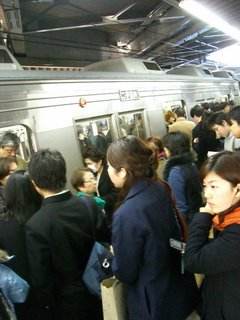 aking his head slowly and with a resigned look on his face, the nice Transit Officer shoved my card into his little reader, pressed a few buttons, and then released me to once again course the rails with the misguided enthusiasm of the blissfully ignorant.) Or, that you should not lean against the Train Conductors door when on the train, and most of all, when he begins to shove the door open from his side in frusteration, you should not suddenly spring aside to allow him to make a most dramatic entrance into the car!
aking his head slowly and with a resigned look on his face, the nice Transit Officer shoved my card into his little reader, pressed a few buttons, and then released me to once again course the rails with the misguided enthusiasm of the blissfully ignorant.) Or, that you should not lean against the Train Conductors door when on the train, and most of all, when he begins to shove the door open from his side in frusteration, you should not suddenly spring aside to allow him to make a most dramatic entrance into the car!
Your first task on the road to enlightenment is to actually find the train-station in the first place. This is not always as easy as one might think, but I have found that the two best techniques are; head for the big buildings and/or businesses since they are almost always clustered around the station, or, when you see a number of people charging down the sidewalk at a lively pace, follow them. Do not follow a tightly packed group of such people; they have just gotten off the train - try to figure out from whence they came. As a last-ditch alternative, pull out a map, open it, and try to look around with a puzzled exoression on your fac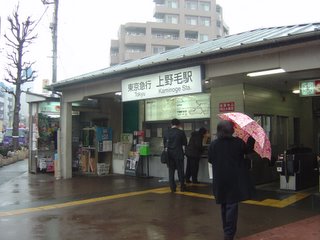 e as a group approaches. Someone will stop to provide directions. (P.S. this technique does not work if the group are gaijin! )
e as a group approaches. Someone will stop to provide directions. (P.S. this technique does not work if the group are gaijin! )
You know you are there when you find any of the following; a cigarette smoking magazine merchant standing behind his formidable array of wares; a pile of stacked bicycles sitting at the side of the road; a Koban Stand (this is the local police station, which is the home base for the police bicycle patrols, the drop-in centre for the odd confused commuter, and the seasonal locale for raffle tickets to charity 'do's' or some similar extortionary undertaking), or, (best of all), you come across the local Jiffy Pho to Booth. The Jiffy Photo Booth is a great little neighborhood innovation here in Japan; within its curtained door you can take black and white or colour pictures for passports, drivers licence, visas, or even family portraits (as long as the family is sufficently small to get into the booth in the first place!). All for just $7! The photo above is the magazine stand and ticket machines at the Kaminoge Station. The white building at the right is the local Koban, and the White Machine at the left is the side view of the Photo Booth.
to Booth. The Jiffy Photo Booth is a great little neighborhood innovation here in Japan; within its curtained door you can take black and white or colour pictures for passports, drivers licence, visas, or even family portraits (as long as the family is sufficently small to get into the booth in the first place!). All for just $7! The photo above is the magazine stand and ticket machines at the Kaminoge Station. The white building at the right is the local Koban, and the White Machine at the left is the side view of the Photo Booth.
Even better yet, if you find the Koban, the cigarette-smoking magazine vendor, the stack of bicycles, AND the Jiffy Photo Booth, you have definately arr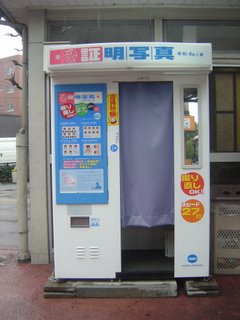 ived! Note that finding vending machines alone, (even as many as 7 of them), is not an indication that this is the train station; vending machines are everywhere in Japan - parks, parking lots, on steet corners and even in washrooms.
ived! Note that finding vending machines alone, (even as many as 7 of them), is not an indication that this is the train station; vending machines are everywhere in Japan - parks, parking lots, on steet corners and even in washrooms.
The next task is to get into the station. In this regard, you must deal with a constant nemesis whose nasty habits you will come to know well; the mechanical ticket taking machine. Innocent looking to the uninitiated, this infernal device is simply a waist-high narrow little lane through which you must pass both entering and exiting the station. However, before you deal with this mechanized Partner of Satan, you must first know which of the two basic ticket systems, a Swipe Pass or a paper Ticket, is called for. That, in turn, depends up whether the train you will board is a Public line using the swipe pass, or a Private line using a paper pass. Here you have to consult the map or know where you are going; any train bearing the letters JR (Japan Rail) is public, so use the swipe card. For everything else you go the paper route. Alternatively, there is usually a one-time ticket dispensing machine at the side of the entrance, so you can have hours of fun trying your luck at figuring out the tariff (depends on the line and the distance), plugging the machine with part of your immens e collection of pocket coins, and hoping for the best. (Kinda' like Vega - sometimes you win, sometimes you lose, but the odds are always with the house in this game!)
e collection of pocket coins, and hoping for the best. (Kinda' like Vega - sometimes you win, sometimes you lose, but the odds are always with the house in this game!)
So, approaching the ticket lanes with what is niavely thought to be the correct voucher firmly clutched in a sweaty hand, one must now select the actual lane to use. This is not as straight-forward as one might think, since the machines can be used for commuters both going in and out of the station, depending on which one gets to their side first! This initial potential clash of wills is usually best reserved for later in the excursion, so I have found it best at this stage to simply meld into a continuous stream of shuffling bodies and count on them to maintain the Right of Way by sheer numbers. (Note that this strategy can have certain consequences if things happen to go wrong at this point, as they are want to do. These are discussed below.) Above; the magazine shop at a subway station in close-up.
Timing and technique are now paramont to a smooth entry (and exit, I might add). Of course, as in most things, there is a 'catch'. The catch, in point of fact, comes in the form of two paddle doors at the far end of the machine; i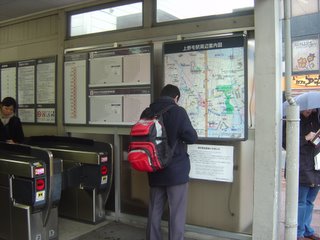 f anything goes 'wrong' at this point, (not enough money on the card, you used the wrong card, the machine screwed up or this is a day ending with the letter 'Y'), two little paddle doors swing closed, and the red 'Idiot Light' at the back of the machine lights up. This instantly summons the stoic Transit Inspector from the comfort of his heated booth to attend yet another seance with a confused and befuddled traveller with bad or non-existant Japanese who actually thinks that the best way for a non-English speaker to understanding what is being said is to speak English really loud!
f anything goes 'wrong' at this point, (not enough money on the card, you used the wrong card, the machine screwed up or this is a day ending with the letter 'Y'), two little paddle doors swing closed, and the red 'Idiot Light' at the back of the machine lights up. This instantly summons the stoic Transit Inspector from the comfort of his heated booth to attend yet another seance with a confused and befuddled traveller with bad or non-existant Japanese who actually thinks that the best way for a non-English speaker to understanding what is being said is to speak English really loud!
And, just to add a little hilarity to the otherwise dull and meaningless lives of the daily commuter, a loud bell rings so that everyone else in the station can roll their eyes and shake their heads at the unworthy, who feel shame under their searing scruity. Above, the ticket-taking machines at Kamanoge.
Now, recall that earlier I indicated that this Join-The-Stream Entry Strategy had consequences in the case of a miscue. When performed with dexteriety and grace the Flowing Exit Move is, indeed, an exquisite ballet with commuters deftly swiping cards or inserting paper at one end of the machine, while smoothly stepping ahead some 5 feet to where the paper card or ticket will magically re-appear, suitably embossed with the name of the entering station. There is also a little LCD screen that one can glance at while deftly plucking the paper from the slot, and it will record your initial entry by deducting a base entry fee as well as tell you what you have left in credit on the card. The whole procedure takes place in the blink of an eye, and results in the line of commuters sweeping into the station in a single, fluid motion.
Likewise, at the exit a similar Swarm Lake ballet occurs. hundreds of individuals effortlessly swipe or insert cards, step ahead while the machine calculates the amount owed, deducts it from the pass or takes the ticket, and then displays the updated amount remaining on the card which pops up and into the commuter's hand at precisely the instant they flit by and then fade into the bubbling masses. Such elegance, such grace!
The problem comes when things don't go right. The carless commuter might hang onto the paper either too tighty (the machine can't pick it up), or too lightly (it drops from the slot before it can be picked up). You might use the wrong card for this particular station, you might not allow the person ahead sufficient time to retrieve their pass before you instert yours, your card might not have any money left on it, you might have two back-to-back entrances recorded on your pass, or the machine might simply just have decided that it needed a break from the same old boring routine.
In all of these cases, the machine is not happy, and when aroused, it slams two paddle doors in your path and will not allow you to proceed. This instantly brings the smooth-flowing stream to a screetching halt. Not expecting a physical obsticle to suddenly appear and block the way, the unwary, (especially gaijin, who tend to be taller), can be tripped by the determined little paddles, and go ass-over-tea-kettle onto the floor on the other side; papers, bags and umbrellas flying. Furthermore, there is instantly a chain reaction crash as commuter after commuter piles into the person in front, who has unexpectedly come to a complete halt. Now there is chaos as everyone has to pick up themselves and their things, organize the entire group caught within the confines of the lane to back out, (not an easy thing to do at the best of times), and then the complete disruption vested on the neighboring lines by the scramble for a machine that 'works' rather than sit through yet another of those painful and time-consuming Transit Officer Seances. However, before too long the slot will be back in business, looking for yet another victim in its relentless 'Catch and Release' campaign.
Once in the station, the challenge now now is to find the correct platform. The clever Japanese often conceal these in all manner of unexpected places ahead, behind, beside, above or even below you. Your task at this point is to thwart all of this insidious plotting by actually finding the correct platform. However, stumbling and thrasing through streams of migrating Salarymen is never easy going, so make sure that you allow plenty of time to be badly confused during your mis-adventure.
When you finally locate that elusive platform, it is also a great idea to ma ke sure that you board a train going the right direction; for every train going uptown, there is another one going the other way! Thus, there are two sides to every platform, (unless you are talking about a politician's speech). At this point you must know the name of the station at the end of the Line that on the route you are seeking. For example, if I were to be going to Juygoaka, I have to know that it is on the train heading to Oimachi. The arriving trains only bear the name of the last station on the route; not the actual station that you are destined for. Don't forget; your ingrained sence of direction will often fail since the trains, like the cars in Japan, use the 'other' side of the road. If you are confused at this stage, haul out the map, and put on your best Puzzled Tourist Face and hope for assistance from your fellow commuters. (this stunt is wearing a little thin at the local station; the next time I am in the 100 Yen Store I must remember to pick up a cheap pair of sunglasses and a collapsible white cane).
ke sure that you board a train going the right direction; for every train going uptown, there is another one going the other way! Thus, there are two sides to every platform, (unless you are talking about a politician's speech). At this point you must know the name of the station at the end of the Line that on the route you are seeking. For example, if I were to be going to Juygoaka, I have to know that it is on the train heading to Oimachi. The arriving trains only bear the name of the last station on the route; not the actual station that you are destined for. Don't forget; your ingrained sence of direction will often fail since the trains, like the cars in Japan, use the 'other' side of the road. If you are confused at this stage, haul out the map, and put on your best Puzzled Tourist Face and hope for assistance from your fellow commuters. (this stunt is wearing a little thin at the local station; the next time I am in the 100 Yen Store I must remember to pick up a cheap pair of sunglasses and a collapsible white cane).
OK, we are almost ready to board now, so careful attention to the boarding strategy at this point will pay off. The thing is, there are often three types of trains that run the route. An Express, A Limited Express, and A Local. All cost the same, but the time to run the route and where they actually stop varies. As you probably have guessed, the Local is the slow boat, and it humps along to every whistle-stop and tumbleweed corner between Here and There. Avoid it if you can.
Usually you want an Express, which rips by all the little stuff and only stops at major stations. Unless one of those stations it bypasses is the one you want, right? There is no greater Malox Moment than glancing up from your Tractor Weekly magazine to see your station zipping by the windows! And, contrary to 'our' logic, the Limited Express train actually has fewer stops than does the Express!! It is the fastest train for long commutes, by far, but again, it must stop where you want to get off, or rethink the strategy.
So, with this basic knowledge at hand, a few minutes doing a little Linear Programming and complex Markovian Analysis on your handheld PC will tell you whether you should take the soon-to-arrive Express, or wait the extra 11 minutes for the Limited Express. Or, you can just say the hell with it, and take the next damn train!
That critical decision made, it is now time to move into the first part of the execution stage; the selection of the actual entry point of the train. Yet again, this has consequences that must be taken into account if an optimum solution is to be achieved.
There are usually little marks on the edge of the platform that indicate where the carriage doors will be when the train stops. Be careful though; sometimes there trains of varying length that use the station so be extremely careful if you line up at a narj that us outside of the existing people lounging around these marks. A good rule of thumb is that if you think you are onto something good, you aren't! These people know what they are doing, so it is a bad mistake to think that you are move clever than they.
Now, stolling down the platform, while keeping an eye on the platform marks, try to judge the size and nature of the people already hanging around. Also, if you know the station that you are going to, try to remember where the stairs and escalator are located; choose line-ups that are (will be) close to these station fixtures if possible. This will save considerable pushing and shoving later when you are fighting for the exit. Remember, even if there is a loose group scattered about, there is still a 'line-up' for the platform marks, although it is somewhat informal. Don't cut the queue; that is bad form, even if such behaviour is not unexpected from us gaijin.
Me, I look for a short line; full of little old ladies, the psychologically disturbed and the infirmed if possible. In a couple of minutes, it will be everyone for themselves! The lines are always two people wide; no more - no less. If only one person is in the line ahead of you, you can step up to their side without fear of reprisal. While waiting in line, stare ahead, but continue to scan ahead of you and the other side of the line with your peripherial vision. Never move your head; that only alerts the others as to your intentions. Assess each new 'joiner' as a possible threat; the most feared of which is the dreaded Salaryman. These Masters of the Masses are inevitably dress in black suits, have short-clipped hair (much harder to grasp in hand-to-hand combat), and are aged 30 - 65. They are easily recognized by their cellphones, the heavy briefcase they sport (soon to become a lethal weapon in their quest for advantage), and are habitually seen carrying either a Japanese Anime Cartoon Book or an automole magzaine. Savvy in the ways of the road, toughened by decades of commuting, and willing to do anything to achieve their aim, these are fierce competitors. They will also be scanning and assessing you, so don't allow them to gain a psychological advantage by letting your anxieties show.
When the train stops, the two lines at the boarding marks will split to either side to allow the crush getting off to expload onto the platform. Ony once will you make the mistake of remaining in place at the platform mark when the door open, so stay alert! Then, as the last of the stragglers fumble out, the two lines will beging to shuffle into the car. It is at this point that the 'Sneaky Pete' move is usually put into play. This consists of a an individual who, not willing to remain at the back of the line boarding the train, decides to try an end-run by slipping between the line-up and the railcar, to emerge at the door. The way to deal with this ploy is to either have established body position in such a manner so as to block his progress, or to angle the guy into the side of the train while moving foreward. When performing this latter move, timing is everything, and it is vital to execute this blocking move in such a way that you appear unaware that anyone is attempting to slither by you. Again, it is vital to keep the head perfectly forward when he slams into the side of the train. Otherwise it looks like you intended to plaster the poor guy, and you, (as well as he), lose Face.
The idea now that the doors are clear is to quickly get around the little old ladies, the aged and the infirm, so be quick about it and vault to the head of the pack. Step over the little old ladies, whip around the slugs, and dance like you have never danced before. As you enter the carriage, quickly size up the car, and head for a vacant seat. Unfortunately, the Salaryman was out of the blocks ahead of me, and is much superior at broken field running. I attempt to keep up, but I must admit that on this day he was the better man. Then, with my objective almost in my grasp, out of nowhere someone appeared from the other end of the car and slipped into the seat. Darn! Doing a 180, I headed for the back-up seat on the other side of the car, but it, too, it snatched from me at the last minute. By the lady in the walker, who just smilec at me as she sank into the seat! Now its a last-ditch scramble for the head-wackers (the overhead rings), but they are disappearing faster than the desert tray at a buffet.
Panicking, I now make a critical error by attempting to head back towards the door, get overwhelmed by the inrush, and end up in the middle of the crowd with no overhead ring for support. Total defeat! My only option now is to get good at Train Surfing until the car completely fills up in three or four stops.
Train Surfing is a little-known sport indulged on the Tokyo subway mainly by youths, and incompetent ri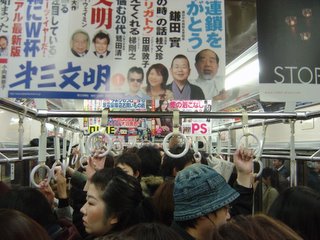 ders. It consists of standing in the middle of the train with no support, and trying to stay on your feet while the train rockets onwards. It is important to keep flex in your legs, anticipate the starts, stops and rolls of the car, and pray that you don't have that lead-foot on the train brake that sent you flying into the Cyndie Lauper Clone the last time you tried your hand at this uniquely Japanese urban skill.
ders. It consists of standing in the middle of the train with no support, and trying to stay on your feet while the train rockets onwards. It is important to keep flex in your legs, anticipate the starts, stops and rolls of the car, and pray that you don't have that lead-foot on the train brake that sent you flying into the Cyndie Lauper Clone the last time you tried your hand at this uniquely Japanese urban skill.
Remember, if you are one of those unfortunate persons left standing in the open by the carriage doors, proper ettiquette demands that you face the door you just entered. The reason for this will become apparant in the paragraph below; never stand face to face with your fellow strap-hangers. The only exception to this rule is made for the two-three rows of humanity on the other side of the carriage; they are allowed to turn and face the door on that side. However, where the two groups meet it always butt-to-butt; never face to face.
Fifteen minutes later you no longer have to worry about the propect of a face plant into the backpack carried by the Elvis Imitator beside you; you are already there! The carriage is now so packed, you can't even scratch your nose. It took me weeks to figure out how they got everone in so tight, but the technique is to back into the crowd standing in the doorway, reach up with both hands on the overhead sill, and heave with all of your might. The crush is incredible; never carry your peanut butter and jam sandwich in a shirt pocket!
So, now its time to settle in for the ride. Most people tune out by staring at their phones if they can reach them, or reading their book. I pass the time holding my breath, and trying to figure out what the people around me have on their belts and in their pockets. Unfortunately, at this point the windows often steam over, so if you are unfamiliar with the station, you had better hope that someone wipes a window so you can at least squint out at the mostly-indescipherable symbols on the stations.
At last you arrive at your station and now it is time to disgorge. If it is a major station and you happen to be near the doors, no problem; you will be literally swept off the train with the rush. The problem arises with gaijin who are caught in the middle of the car; often they fail to recognize the station until the train is stopped and most people are off. Experienced trainriders simply shove their way past in a most determined manner, but there is another way. Standing up, in a loud voice exclaim Sumimasen! Sumimasen! [Excuse Me! Excuse Me!] And, in an emergency one can also extend a straight-arm with an open hand indicating the direction you wish to go while shouting his phrase.
This act will draw everyones attention immediately; nobody talks in anything louder than a whisper but the gaijin. And, a physical gesture in public is astonishing to the local Japanese, who don't shake hands, bow with their arms tightly tucked against their bodies, and who avoid showing emotional reactions anywhere in public except sporting events. Neither Moses nor my barber could be more effective at parting the way than this simple act, and you can then immediately get on to fighting with the inrushing crowd, who are most eager to occupy your seat. Determined failing with both arms in a sort of swimming motion is about the only way to make progress when dealing with this onrushing current of humanity.

Once on the platform, join a stream of commuters and they will automatically sweep you towards the exit. A quick thrash around for the escalator or stairs, a final run at the infernal ticket machines and the groin-bashers that pass for paddles, and you are then out of the station, and on your way!
So, surviving the subway is an acquired skill necessary to survive in Tokyo. But privledged few ever become true masters at the art; this takes years of dedicated effort. You can recognize the true Masters of the Transit System in subtile ways; they know such intimate details about the system as, for example:
The subway system here is truly awesome, bu
 t only once the traveller can decipher some of the deeper mysteries and concealed beauty of its internal workings. Like, the basic train-routes, for one thing. The attached photo gives you just a hint of the formidible complexity that lies waiting within the bowels of this sprawling transportation system. The Greater Tokyo Subway System is an intricate blend of both private and public rail companies, each with different rolling stock, signage, fare rates, passes, schedules, and even station layouts. The language barrier you face, (typically you can't even read the signs), only deepens the challenge. At first it is all just a confusing jumble of seemingly choatic and randomly selected physical and mental tests of your will and endurance. But, if you can percievere, the subway system slowly begins to reveal the true beauty of its inner workings to the prevlidged cognesenti.
t only once the traveller can decipher some of the deeper mysteries and concealed beauty of its internal workings. Like, the basic train-routes, for one thing. The attached photo gives you just a hint of the formidible complexity that lies waiting within the bowels of this sprawling transportation system. The Greater Tokyo Subway System is an intricate blend of both private and public rail companies, each with different rolling stock, signage, fare rates, passes, schedules, and even station layouts. The language barrier you face, (typically you can't even read the signs), only deepens the challenge. At first it is all just a confusing jumble of seemingly choatic and randomly selected physical and mental tests of your will and endurance. But, if you can percievere, the subway system slowly begins to reveal the true beauty of its inner workings to the prevlidged cognesenti.From time to time, the niave Gaijin trying out the subway system for the first few weeks will get hints of the hidden order of the universe as sort of a 'freebe' gift from the Gods of Displacement. Unfortunately, we miserable neophytes are usually too ignorant to even see, let alone understand, this enlightening act of unsolicited benevelance. This 'gift of insight' usually appears in such magical forms as: you are the only person lined up for the train on the LEFT side of the platform, while everyone else is standing on the RIGHT side. Or, your train rolls into the station and EVERYONE ELSE gets off, leaving you sitting in an empty car and wondering where they are all going. (If you are lucky, the conductor will take pity on you, enter the car, and explain as best he can that this is END OF THE LINE.) Or, (one of my personal favourites), you notice that the station-name symbols on the EXIT sign at the station are EXACTLY THE SAME as the ones that were above the ENTRANCE sign of the station from which you departed three transfers and 90 minutes ago!
No, we miserable and much-pitied Gaijin usually ignore these acts of gratitutious mercy; we prefer to learn most things the hard way. Like, when the train says it will be here at 10:36 it will! Not at 10:35, or even 10:39. So don't count on it being there if you are even ONE MINUTE late! Also, if you think you got a deal because the ticket taking machine at the exit wasn't working when you left, the next time you enter the system it will think that you have been wandering aimlessly throughout its innards for the past three days and will try to charge you accordingly! (This resulted in me smiling at a stoic Transit Official in the little booth and mumbling over and over the word Akaharara! - the only word from my extensive vocabulary of Japanese For Dummies that he seemed willing to admit might even possibly be in his native tongue. ) [Akahabara is a major station on the line, where the maintenance work on its ticket machines is obviously suspect.] Sh
 aking his head slowly and with a resigned look on his face, the nice Transit Officer shoved my card into his little reader, pressed a few buttons, and then released me to once again course the rails with the misguided enthusiasm of the blissfully ignorant.) Or, that you should not lean against the Train Conductors door when on the train, and most of all, when he begins to shove the door open from his side in frusteration, you should not suddenly spring aside to allow him to make a most dramatic entrance into the car!
aking his head slowly and with a resigned look on his face, the nice Transit Officer shoved my card into his little reader, pressed a few buttons, and then released me to once again course the rails with the misguided enthusiasm of the blissfully ignorant.) Or, that you should not lean against the Train Conductors door when on the train, and most of all, when he begins to shove the door open from his side in frusteration, you should not suddenly spring aside to allow him to make a most dramatic entrance into the car!Your first task on the road to enlightenment is to actually find the train-station in the first place. This is not always as easy as one might think, but I have found that the two best techniques are; head for the big buildings and/or businesses since they are almost always clustered around the station, or, when you see a number of people charging down the sidewalk at a lively pace, follow them. Do not follow a tightly packed group of such people; they have just gotten off the train - try to figure out from whence they came. As a last-ditch alternative, pull out a map, open it, and try to look around with a puzzled exoression on your fac
 e as a group approaches. Someone will stop to provide directions. (P.S. this technique does not work if the group are gaijin! )
e as a group approaches. Someone will stop to provide directions. (P.S. this technique does not work if the group are gaijin! )You know you are there when you find any of the following; a cigarette smoking magazine merchant standing behind his formidable array of wares; a pile of stacked bicycles sitting at the side of the road; a Koban Stand (this is the local police station, which is the home base for the police bicycle patrols, the drop-in centre for the odd confused commuter, and the seasonal locale for raffle tickets to charity 'do's' or some similar extortionary undertaking), or, (best of all), you come across the local Jiffy Pho
 to Booth. The Jiffy Photo Booth is a great little neighborhood innovation here in Japan; within its curtained door you can take black and white or colour pictures for passports, drivers licence, visas, or even family portraits (as long as the family is sufficently small to get into the booth in the first place!). All for just $7! The photo above is the magazine stand and ticket machines at the Kaminoge Station. The white building at the right is the local Koban, and the White Machine at the left is the side view of the Photo Booth.
to Booth. The Jiffy Photo Booth is a great little neighborhood innovation here in Japan; within its curtained door you can take black and white or colour pictures for passports, drivers licence, visas, or even family portraits (as long as the family is sufficently small to get into the booth in the first place!). All for just $7! The photo above is the magazine stand and ticket machines at the Kaminoge Station. The white building at the right is the local Koban, and the White Machine at the left is the side view of the Photo Booth.Even better yet, if you find the Koban, the cigarette-smoking magazine vendor, the stack of bicycles, AND the Jiffy Photo Booth, you have definately arr
 ived! Note that finding vending machines alone, (even as many as 7 of them), is not an indication that this is the train station; vending machines are everywhere in Japan - parks, parking lots, on steet corners and even in washrooms.
ived! Note that finding vending machines alone, (even as many as 7 of them), is not an indication that this is the train station; vending machines are everywhere in Japan - parks, parking lots, on steet corners and even in washrooms.The next task is to get into the station. In this regard, you must deal with a constant nemesis whose nasty habits you will come to know well; the mechanical ticket taking machine. Innocent looking to the uninitiated, this infernal device is simply a waist-high narrow little lane through which you must pass both entering and exiting the station. However, before you deal with this mechanized Partner of Satan, you must first know which of the two basic ticket systems, a Swipe Pass or a paper Ticket, is called for. That, in turn, depends up whether the train you will board is a Public line using the swipe pass, or a Private line using a paper pass. Here you have to consult the map or know where you are going; any train bearing the letters JR (Japan Rail) is public, so use the swipe card. For everything else you go the paper route. Alternatively, there is usually a one-time ticket dispensing machine at the side of the entrance, so you can have hours of fun trying your luck at figuring out the tariff (depends on the line and the distance), plugging the machine with part of your immens
 e collection of pocket coins, and hoping for the best. (Kinda' like Vega - sometimes you win, sometimes you lose, but the odds are always with the house in this game!)
e collection of pocket coins, and hoping for the best. (Kinda' like Vega - sometimes you win, sometimes you lose, but the odds are always with the house in this game!)So, approaching the ticket lanes with what is niavely thought to be the correct voucher firmly clutched in a sweaty hand, one must now select the actual lane to use. This is not as straight-forward as one might think, since the machines can be used for commuters both going in and out of the station, depending on which one gets to their side first! This initial potential clash of wills is usually best reserved for later in the excursion, so I have found it best at this stage to simply meld into a continuous stream of shuffling bodies and count on them to maintain the Right of Way by sheer numbers. (Note that this strategy can have certain consequences if things happen to go wrong at this point, as they are want to do. These are discussed below.) Above; the magazine shop at a subway station in close-up.
Timing and technique are now paramont to a smooth entry (and exit, I might add). Of course, as in most things, there is a 'catch'. The catch, in point of fact, comes in the form of two paddle doors at the far end of the machine; i
 f anything goes 'wrong' at this point, (not enough money on the card, you used the wrong card, the machine screwed up or this is a day ending with the letter 'Y'), two little paddle doors swing closed, and the red 'Idiot Light' at the back of the machine lights up. This instantly summons the stoic Transit Inspector from the comfort of his heated booth to attend yet another seance with a confused and befuddled traveller with bad or non-existant Japanese who actually thinks that the best way for a non-English speaker to understanding what is being said is to speak English really loud!
f anything goes 'wrong' at this point, (not enough money on the card, you used the wrong card, the machine screwed up or this is a day ending with the letter 'Y'), two little paddle doors swing closed, and the red 'Idiot Light' at the back of the machine lights up. This instantly summons the stoic Transit Inspector from the comfort of his heated booth to attend yet another seance with a confused and befuddled traveller with bad or non-existant Japanese who actually thinks that the best way for a non-English speaker to understanding what is being said is to speak English really loud!And, just to add a little hilarity to the otherwise dull and meaningless lives of the daily commuter, a loud bell rings so that everyone else in the station can roll their eyes and shake their heads at the unworthy, who feel shame under their searing scruity. Above, the ticket-taking machines at Kamanoge.
Now, recall that earlier I indicated that this Join-The-Stream Entry Strategy had consequences in the case of a miscue. When performed with dexteriety and grace the Flowing Exit Move is, indeed, an exquisite ballet with commuters deftly swiping cards or inserting paper at one end of the machine, while smoothly stepping ahead some 5 feet to where the paper card or ticket will magically re-appear, suitably embossed with the name of the entering station. There is also a little LCD screen that one can glance at while deftly plucking the paper from the slot, and it will record your initial entry by deducting a base entry fee as well as tell you what you have left in credit on the card. The whole procedure takes place in the blink of an eye, and results in the line of commuters sweeping into the station in a single, fluid motion.
Likewise, at the exit a similar Swarm Lake ballet occurs. hundreds of individuals effortlessly swipe or insert cards, step ahead while the machine calculates the amount owed, deducts it from the pass or takes the ticket, and then displays the updated amount remaining on the card which pops up and into the commuter's hand at precisely the instant they flit by and then fade into the bubbling masses. Such elegance, such grace!
The problem comes when things don't go right. The carless commuter might hang onto the paper either too tighty (the machine can't pick it up), or too lightly (it drops from the slot before it can be picked up). You might use the wrong card for this particular station, you might not allow the person ahead sufficient time to retrieve their pass before you instert yours, your card might not have any money left on it, you might have two back-to-back entrances recorded on your pass, or the machine might simply just have decided that it needed a break from the same old boring routine.
In all of these cases, the machine is not happy, and when aroused, it slams two paddle doors in your path and will not allow you to proceed. This instantly brings the smooth-flowing stream to a screetching halt. Not expecting a physical obsticle to suddenly appear and block the way, the unwary, (especially gaijin, who tend to be taller), can be tripped by the determined little paddles, and go ass-over-tea-kettle onto the floor on the other side; papers, bags and umbrellas flying. Furthermore, there is instantly a chain reaction crash as commuter after commuter piles into the person in front, who has unexpectedly come to a complete halt. Now there is chaos as everyone has to pick up themselves and their things, organize the entire group caught within the confines of the lane to back out, (not an easy thing to do at the best of times), and then the complete disruption vested on the neighboring lines by the scramble for a machine that 'works' rather than sit through yet another of those painful and time-consuming Transit Officer Seances. However, before too long the slot will be back in business, looking for yet another victim in its relentless 'Catch and Release' campaign.
Once in the station, the challenge now now is to find the correct platform. The clever Japanese often conceal these in all manner of unexpected places ahead, behind, beside, above or even below you. Your task at this point is to thwart all of this insidious plotting by actually finding the correct platform. However, stumbling and thrasing through streams of migrating Salarymen is never easy going, so make sure that you allow plenty of time to be badly confused during your mis-adventure.
When you finally locate that elusive platform, it is also a great idea to ma
 ke sure that you board a train going the right direction; for every train going uptown, there is another one going the other way! Thus, there are two sides to every platform, (unless you are talking about a politician's speech). At this point you must know the name of the station at the end of the Line that on the route you are seeking. For example, if I were to be going to Juygoaka, I have to know that it is on the train heading to Oimachi. The arriving trains only bear the name of the last station on the route; not the actual station that you are destined for. Don't forget; your ingrained sence of direction will often fail since the trains, like the cars in Japan, use the 'other' side of the road. If you are confused at this stage, haul out the map, and put on your best Puzzled Tourist Face and hope for assistance from your fellow commuters. (this stunt is wearing a little thin at the local station; the next time I am in the 100 Yen Store I must remember to pick up a cheap pair of sunglasses and a collapsible white cane).
ke sure that you board a train going the right direction; for every train going uptown, there is another one going the other way! Thus, there are two sides to every platform, (unless you are talking about a politician's speech). At this point you must know the name of the station at the end of the Line that on the route you are seeking. For example, if I were to be going to Juygoaka, I have to know that it is on the train heading to Oimachi. The arriving trains only bear the name of the last station on the route; not the actual station that you are destined for. Don't forget; your ingrained sence of direction will often fail since the trains, like the cars in Japan, use the 'other' side of the road. If you are confused at this stage, haul out the map, and put on your best Puzzled Tourist Face and hope for assistance from your fellow commuters. (this stunt is wearing a little thin at the local station; the next time I am in the 100 Yen Store I must remember to pick up a cheap pair of sunglasses and a collapsible white cane).OK, we are almost ready to board now, so careful attention to the boarding strategy at this point will pay off. The thing is, there are often three types of trains that run the route. An Express, A Limited Express, and A Local. All cost the same, but the time to run the route and where they actually stop varies. As you probably have guessed, the Local is the slow boat, and it humps along to every whistle-stop and tumbleweed corner between Here and There. Avoid it if you can.
Usually you want an Express, which rips by all the little stuff and only stops at major stations. Unless one of those stations it bypasses is the one you want, right? There is no greater Malox Moment than glancing up from your Tractor Weekly magazine to see your station zipping by the windows! And, contrary to 'our' logic, the Limited Express train actually has fewer stops than does the Express!! It is the fastest train for long commutes, by far, but again, it must stop where you want to get off, or rethink the strategy.
So, with this basic knowledge at hand, a few minutes doing a little Linear Programming and complex Markovian Analysis on your handheld PC will tell you whether you should take the soon-to-arrive Express, or wait the extra 11 minutes for the Limited Express. Or, you can just say the hell with it, and take the next damn train!
That critical decision made, it is now time to move into the first part of the execution stage; the selection of the actual entry point of the train. Yet again, this has consequences that must be taken into account if an optimum solution is to be achieved.
There are usually little marks on the edge of the platform that indicate where the carriage doors will be when the train stops. Be careful though; sometimes there trains of varying length that use the station so be extremely careful if you line up at a narj that us outside of the existing people lounging around these marks. A good rule of thumb is that if you think you are onto something good, you aren't! These people know what they are doing, so it is a bad mistake to think that you are move clever than they.
Now, stolling down the platform, while keeping an eye on the platform marks, try to judge the size and nature of the people already hanging around. Also, if you know the station that you are going to, try to remember where the stairs and escalator are located; choose line-ups that are (will be) close to these station fixtures if possible. This will save considerable pushing and shoving later when you are fighting for the exit. Remember, even if there is a loose group scattered about, there is still a 'line-up' for the platform marks, although it is somewhat informal. Don't cut the queue; that is bad form, even if such behaviour is not unexpected from us gaijin.
Me, I look for a short line; full of little old ladies, the psychologically disturbed and the infirmed if possible. In a couple of minutes, it will be everyone for themselves! The lines are always two people wide; no more - no less. If only one person is in the line ahead of you, you can step up to their side without fear of reprisal. While waiting in line, stare ahead, but continue to scan ahead of you and the other side of the line with your peripherial vision. Never move your head; that only alerts the others as to your intentions. Assess each new 'joiner' as a possible threat; the most feared of which is the dreaded Salaryman. These Masters of the Masses are inevitably dress in black suits, have short-clipped hair (much harder to grasp in hand-to-hand combat), and are aged 30 - 65. They are easily recognized by their cellphones, the heavy briefcase they sport (soon to become a lethal weapon in their quest for advantage), and are habitually seen carrying either a Japanese Anime Cartoon Book or an automole magzaine. Savvy in the ways of the road, toughened by decades of commuting, and willing to do anything to achieve their aim, these are fierce competitors. They will also be scanning and assessing you, so don't allow them to gain a psychological advantage by letting your anxieties show.
When the train stops, the two lines at the boarding marks will split to either side to allow the crush getting off to expload onto the platform. Ony once will you make the mistake of remaining in place at the platform mark when the door open, so stay alert! Then, as the last of the stragglers fumble out, the two lines will beging to shuffle into the car. It is at this point that the 'Sneaky Pete' move is usually put into play. This consists of a an individual who, not willing to remain at the back of the line boarding the train, decides to try an end-run by slipping between the line-up and the railcar, to emerge at the door. The way to deal with this ploy is to either have established body position in such a manner so as to block his progress, or to angle the guy into the side of the train while moving foreward. When performing this latter move, timing is everything, and it is vital to execute this blocking move in such a way that you appear unaware that anyone is attempting to slither by you. Again, it is vital to keep the head perfectly forward when he slams into the side of the train. Otherwise it looks like you intended to plaster the poor guy, and you, (as well as he), lose Face.
The idea now that the doors are clear is to quickly get around the little old ladies, the aged and the infirm, so be quick about it and vault to the head of the pack. Step over the little old ladies, whip around the slugs, and dance like you have never danced before. As you enter the carriage, quickly size up the car, and head for a vacant seat. Unfortunately, the Salaryman was out of the blocks ahead of me, and is much superior at broken field running. I attempt to keep up, but I must admit that on this day he was the better man. Then, with my objective almost in my grasp, out of nowhere someone appeared from the other end of the car and slipped into the seat. Darn! Doing a 180, I headed for the back-up seat on the other side of the car, but it, too, it snatched from me at the last minute. By the lady in the walker, who just smilec at me as she sank into the seat! Now its a last-ditch scramble for the head-wackers (the overhead rings), but they are disappearing faster than the desert tray at a buffet.
Panicking, I now make a critical error by attempting to head back towards the door, get overwhelmed by the inrush, and end up in the middle of the crowd with no overhead ring for support. Total defeat! My only option now is to get good at Train Surfing until the car completely fills up in three or four stops.
Train Surfing is a little-known sport indulged on the Tokyo subway mainly by youths, and incompetent ri
 ders. It consists of standing in the middle of the train with no support, and trying to stay on your feet while the train rockets onwards. It is important to keep flex in your legs, anticipate the starts, stops and rolls of the car, and pray that you don't have that lead-foot on the train brake that sent you flying into the Cyndie Lauper Clone the last time you tried your hand at this uniquely Japanese urban skill.
ders. It consists of standing in the middle of the train with no support, and trying to stay on your feet while the train rockets onwards. It is important to keep flex in your legs, anticipate the starts, stops and rolls of the car, and pray that you don't have that lead-foot on the train brake that sent you flying into the Cyndie Lauper Clone the last time you tried your hand at this uniquely Japanese urban skill.Remember, if you are one of those unfortunate persons left standing in the open by the carriage doors, proper ettiquette demands that you face the door you just entered. The reason for this will become apparant in the paragraph below; never stand face to face with your fellow strap-hangers. The only exception to this rule is made for the two-three rows of humanity on the other side of the carriage; they are allowed to turn and face the door on that side. However, where the two groups meet it always butt-to-butt; never face to face.
Fifteen minutes later you no longer have to worry about the propect of a face plant into the backpack carried by the Elvis Imitator beside you; you are already there! The carriage is now so packed, you can't even scratch your nose. It took me weeks to figure out how they got everone in so tight, but the technique is to back into the crowd standing in the doorway, reach up with both hands on the overhead sill, and heave with all of your might. The crush is incredible; never carry your peanut butter and jam sandwich in a shirt pocket!
So, now its time to settle in for the ride. Most people tune out by staring at their phones if they can reach them, or reading their book. I pass the time holding my breath, and trying to figure out what the people around me have on their belts and in their pockets. Unfortunately, at this point the windows often steam over, so if you are unfamiliar with the station, you had better hope that someone wipes a window so you can at least squint out at the mostly-indescipherable symbols on the stations.
At last you arrive at your station and now it is time to disgorge. If it is a major station and you happen to be near the doors, no problem; you will be literally swept off the train with the rush. The problem arises with gaijin who are caught in the middle of the car; often they fail to recognize the station until the train is stopped and most people are off. Experienced trainriders simply shove their way past in a most determined manner, but there is another way. Standing up, in a loud voice exclaim Sumimasen! Sumimasen! [Excuse Me! Excuse Me!] And, in an emergency one can also extend a straight-arm with an open hand indicating the direction you wish to go while shouting his phrase.
This act will draw everyones attention immediately; nobody talks in anything louder than a whisper but the gaijin. And, a physical gesture in public is astonishing to the local Japanese, who don't shake hands, bow with their arms tightly tucked against their bodies, and who avoid showing emotional reactions anywhere in public except sporting events. Neither Moses nor my barber could be more effective at parting the way than this simple act, and you can then immediately get on to fighting with the inrushing crowd, who are most eager to occupy your seat. Determined failing with both arms in a sort of swimming motion is about the only way to make progress when dealing with this onrushing current of humanity.

Once on the platform, join a stream of commuters and they will automatically sweep you towards the exit. A quick thrash around for the escalator or stairs, a final run at the infernal ticket machines and the groin-bashers that pass for paddles, and you are then out of the station, and on your way!
So, surviving the subway is an acquired skill necessary to survive in Tokyo. But privledged few ever become true masters at the art; this takes years of dedicated effort. You can recognize the true Masters of the Transit System in subtile ways; they know such intimate details about the system as, for example:
- when it is advantageous to take a Local train a stop or two in the opposite direction, in order to catch a Limited Express Train there;
- which stations have Western Toilettes, and how many;

- how to tell at a glance which subway cars have the Ankle Toasters (the heaters) cranked way up, and which do not, (there is a small plaque over the doors of the hotboxes);
- where to find space on a train if you are hauling luggage or bulky packages, (take the second car from the end - that car has one set of seats removed to allow wheelchairs onboard);
- exactly where on the trains to stand and on which side in order to gain the best positional advantage when exiting,
- and other subtle secrets such as, when going to a very small station, do not get on either of the last two cars no matter what; small platforms will not allow the entire train access to the platform, so the doors on the last two cars will not open.
If you are lucky and you hang around these people long enough, and if you stick with it, you, too, can become a member of that most secret of the Underground Societies in Tokyo, the Subway Cognesenti!
Doug-San In Japan
Saying Sayonara for now!

































